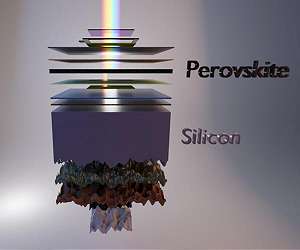Lead halide perovskite nanocrystals (PeNCs) have attracted extensive attention due to their high photoluminescence quantum yield (PLQY), adjustable bandgap, low cost, and excellent photoelectric properties. In recent years, perovskite based light emitting diodes (LEDs) have developed rapidly and become candidates for low-cost, solution-processing based solid-state lighting.
White light perovskite LEDs are possible to be obtained by stacking different NCs with complementary emissions together in one film. However, the halide ion segregation and exchange lead to severe color instability and complex structure in mixed halide perovskite LED devices. Therefore, new ideas and technologies are required for the development of white light devices.
In a new paper published in Light: Science and Application, a team of scientists, led by Professor Hongwei Song from State Key Laboratory of Integrated Optoelectronics, College of Electronic Science and Engineering, Jilin University, China, and co-workers have developed a promising method to fabricate white perovskite LEDs using lanthanides (Ln3+) ions doped CsPbCl3 PeNCs.
Based on Forster-Dexter theory, the bandgap of perovskite host need to be regulated to match with the energy levels of Ln3+ ions considering the different 4f electronic configurations. And specific defect passivation by introducing stronger binding capping ligands is an important approach to improve the performance of PeNC film. Afterwards, the perovskite LEDs based on the Ln3+ ions doped PeNCs experiencing band engineering and defect passivation were fabricated, in which the EL of Ce3+, Er3+, Sm3+, Eu3+ ions are successfully obtained, respectively.
More importantly, the LEDs based 3.5 mol% Eu3+ ions doped PeNCs show the white light emitting, a peak luminance of 1678 cd m-2 and a maximum external quantum efficiency (EQE) of 5.4%, demonstrating excellent performance among existing white PeNCs LEDs from single chip. This work demonstrates the superiority of single-component Ln3+ ions doped perovskite in the realization of highly efficient and stable white LEDs, providing the optimal scheme for the development of low-cost, simple-structure white perovskite LEDs.
Related Links
Jilin University
All About Solar Energy at SolarDaily.com
|
We need your help. The SpaceDaily news network continues to grow but revenues have never been harder to maintain. With the rise of Ad Blockers, and Facebook – our traditional revenue sources via quality network advertising continues to decline. And unlike so many other news sites, we don’t have a paywall – with those annoying usernames and passwords. Our news coverage takes time and effort to publish 365 days a year. If you find our news sites informative and useful then please consider becoming a regular supporter or for now make a one off contribution. |
||
|
SpaceDaily Contributor $5 Billed Once credit card or paypal |
SpaceDaily Monthly Supporter $5 Billed Monthly paypal only |
|

![]()
Tandem solar cell achieves 32.5 percent efficiency
Berlin, Germany (SPX) Dec 20, 2022
Scientists from HZB could significantly improve on the efficiency of perovskite/silicon tandem solar cells. “This is a really big leap forward that we didn’t foresee a few months ago. All the teams involved at HZB, especially the PV Competence Center (PVComB) and the HySPRINT Innovation lab teams have worked together successfully and with passion,” says Prof. Steve Albrecht.
His team used an advanced perovskite composition with a very smart interface modification. The lead authors, postdocs Dr. Si … read more
